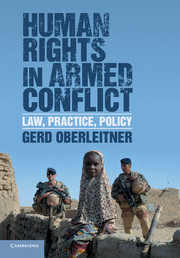Book contents
- Frontmatter
- Contents
- Acknowledgments
- Table of cases
- Table of Legal Instruments
- List of Abbreviations
- Introduction
- Part I Human rights in armed conflict: history of an idea
- Part II Human rights and humanitarian law: theory
- Part III Human rights and humanitarian law: challenges and commonalities
- Part IV The dynamics of war and law
- Part V Enforcement: practice and potential
- 17 United Nations Human Rights Council: monitoring armed conflicts
- 18 United Nations High Commissioner for Human Rights
- 19 United Nations human rights treaty bodies
- 20 The Inter-American human rights system
- 21 The European Court of Human Rights
- 22 The African Commission on Human and Peoples’ Rights
- 23 Monitoring and litigating humanitarian rights: prospects
- Conclusion
- Bibliography
- Index
- References
20 - The Inter-American human rights system
Published online by Cambridge University Press: 05 March 2015
- Frontmatter
- Contents
- Acknowledgments
- Table of cases
- Table of Legal Instruments
- List of Abbreviations
- Introduction
- Part I Human rights in armed conflict: history of an idea
- Part II Human rights and humanitarian law: theory
- Part III Human rights and humanitarian law: challenges and commonalities
- Part IV The dynamics of war and law
- Part V Enforcement: practice and potential
- 17 United Nations Human Rights Council: monitoring armed conflicts
- 18 United Nations High Commissioner for Human Rights
- 19 United Nations human rights treaty bodies
- 20 The Inter-American human rights system
- 21 The European Court of Human Rights
- 22 The African Commission on Human and Peoples’ Rights
- 23 Monitoring and litigating humanitarian rights: prospects
- Conclusion
- Bibliography
- Index
- References
Summary
Applying humanitarian law
The Inter-American Commission was faced with situations of armed conflict in the southern hemisphere of the Inter-American human rights system soon after it had become operational in 1960. To date, no other human rights monitoring body has gone further than the Commission in speaking out on violations of human rights and humanitarian law in situations of armed conflict. Unlike other human rights bodies, it has deliberately sought to accommodate international humanitarian law alongside human rights law when considering such situations.
In the first decade of its existence, from 1959 to 1973, however, the Commission made no reference to international humanitarian law in its jurisprudence, despite the occurrence of armed conflicts in the region, e.g., in Cuba, the Dominican Republic and Chile. Only with the armed conflict in Nicaragua and its on-site visit to the country in 1978 did the Commission take an interest in this matter. The Commission considered this situation as an internal armed conflict under Common Article 3 of the Geneva Conventions and held that the use of heavy artillery and bombardments by the Nicaraguan National Guard against the Sandinista Front for National Liberation amounted to violations of “a basic humanitarian norm.” The precise meaning of this term was not clarified and in the report on Argentina two years later, in 1980, the Commission held that it had no other competence than to investigate human rights violations and would not examine violations of international humanitarian law in armed conflicts. The reason for this restraint may be found in the repeated requests by the General Assembly of the Organization of American States (OAS) to the Commission to investigate not only human rights abuses by governmental authorities but also by non-state armed groups and terrorist organizations. The Commission seemingly did not want to be drawn into examining their conduct even though it began to do so later when it considered the human rights situation in Peru in 1993.
- Type
- Chapter
- Information
- Human Rights in Armed ConflictLaw, Practice, Policy, pp. 271 - 294Publisher: Cambridge University PressPrint publication year: 2015

